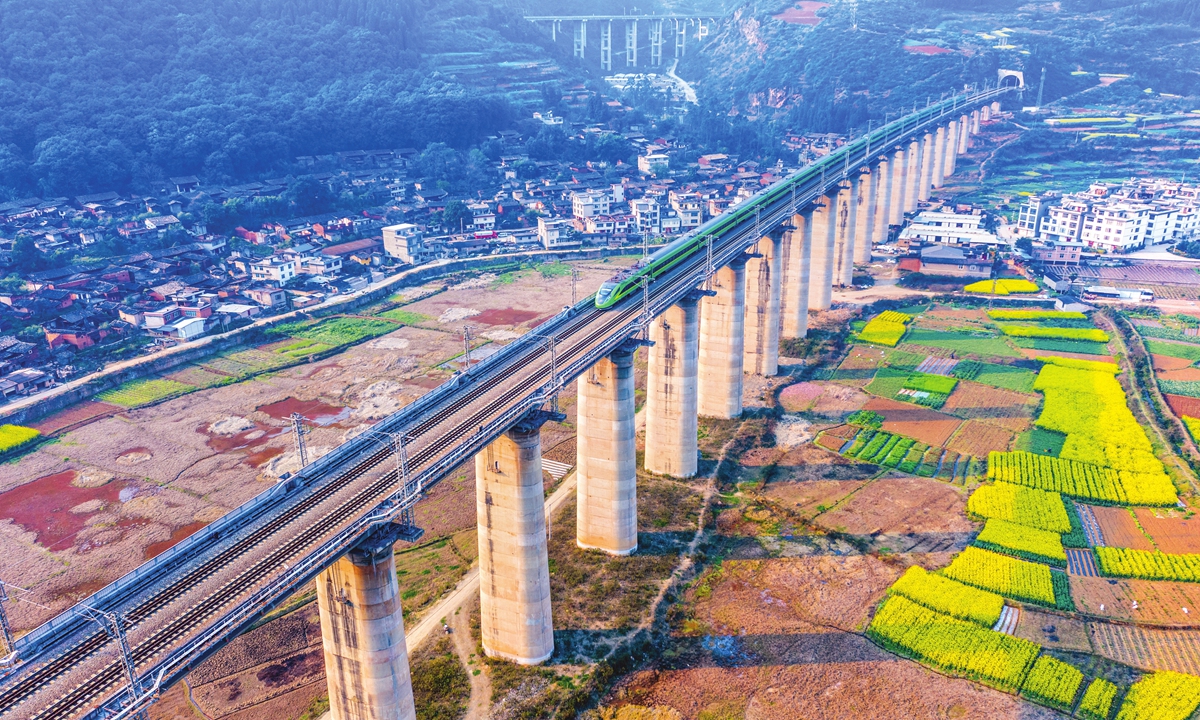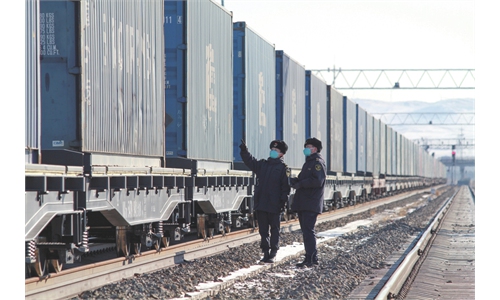China-Laos Railway encapsulates tangible benefits of growing economic link under the BRI over the past decade

A high-speed train on a section of China-Laos Railway in Yuxi, Southwest China's Yunnan Province Photo: VCG
Editor's Note:
In 2013, Chinese President Xi Jinping put forward the "Belt and Road Initiative" (BRI), aiming at building a new platform for international cooperation and creating new momentum for shared development. Since then, the BRI has opened a path for high-quality development and common prosperity for countries along the route, becoming a real global platform serving over half of the world's population.
On December 3, 2021, President Xi and Lao President Thongloun Sisoulith jointly witnessed via video link the opening of the 1,035-kilometer-long China-Laos Railway. A BRI flagship project that saw full scale construction begin in 2016, the railway is an economic powerhouse that facilitates connectivity and fosters growth. Seven months into its operation, the railway has already brought tangible benefits to countries along its route. The Global Times conducted interviews with those who built the railway, traders and cargo operators, who shared how they witnessed the development of southern transportation artery between China and ASEAN under the BRI and its increasingly important and indispensable role for global economy.
Welcome to the third in a series about a monumental decade for the BRI.
"The one thing that surprises me the most is that even the COVID-19 pandemic could not dampen our Lao friends' enthusiasm to ride the China-Laos Railway," Huang Hong, a Chinese engineer who has spent the past six years building the railway, told the Global Times on Thursday.
Describing the railway as transformative, turning Laos from a land-locked country into a land-linked hub, bringing countless local jobs and shortening travel within the country from days to hours, Huang, director of CREC Laos-China Railway Project Construction Headquarters, said nowadays the railway has been an Instagram-Worthy Location.
Huang said that he felt proud as the builder of the project, primarily invested by Chinese companies, which is the first international railway under the BRI, uses all Chinese standards, connects seamlessly with China's domestic rail networks.
Train, goods and hope
"As many local people have benefited greatly from the railway, now many around me are hoping to send their children to embark on overseas study in China, via this railway," Huang said.
Stretching from Kunming in Southwest China's Yunnan Province to Vientiane and reducing cargo transport expenses by 30 to 50 percent, the electrified passenger and cargo railway is becoming an accelerator for regional connectivity and a new engine driving economic cooperation.
More than 20 Chinese provinces and cities have so far opened cross-border freight train services using the railway, which carries more than 100 varieties of goods including fruit, solar and electronic products and reaches destinations in over 10 regional countries including Malaysia and Thailand.
As of July 3, the China-Laos Railway has carried 4.11 million passenger trips and transported 5.03 million tons of cargo, according to a statement sent to the Global Times by state railway operator China State Railway Group Co. Cross-border shipment of cargoes has reached 840,000 tons.
By exploring new business models such as "gate to gate" and intermodal logistics, cold-chain logistics are channeling Yunnan's vegetables and fresh flowers south to Laos and Thailand and to be met with northbound Southeast Asian specialties including durian and mangosteen from Thailand and Vietnam.
The China-Laos railway has a huge flywheel effect. Its 1,000-kilometer-length is dwarfed by the length the goods it carried will go, which has reached Northwest China's Gansu in the northern direction and Singapore in the southern direction and some found themselves embarked onto ships at Thailand's Port of Laem Chabang. The ultimate goal: a 21-day journey from Moscow to Singapore.
For Zeng Cheng, a project director from Kunming-based Yunnan Easy-trans International Freight Forwarder Co, the railway has transformed his business.
Since the opening of railway in December, Zeng's company, a domestic agent doing cross-border trade between China, Laos and other Southeast Asian countries, began to try new business markets, such as the import and export clearance and transportation of bulk materials like fertilizers and cloth, e-commerce materials and fresh fruits.
Zeng told the Global Times on Thursday that through the China-Laos Railway, these materials are sent to other cities in Laos, Thailand and Myanmar by land transport from Kunming to railway station in Laos while his company's major clients have also changed from large state-owned enterprises to foreign private enterprises and individual merchants.
The company's revenue for the first half of 2021 increased by 31.8 percent year-on-year, driven by booming business expansion following the launch of the railway.
"Binbin, a local Lao, and a friend of mine just celebrated his 35th birthday yesterday. In the past, his family was mainly in farming and his income was very low. After the Laos railway was built, he applied for a technical apprenticeship for railway maintenance. Through the study, training and assessment in railway work, he is now a technical engineer," Zeng said.
For Binbin, the railway gave him a new skill set in addition to a good income that supports his family, Zeng added.
Indeed, Chinese Foreign Ministry spokesperson Zhao Lijian on July 1 hailed the railway as a vivid example of the high-quality Belt and Road cooperation between China and ASEAN members and a strong testament to their joint efforts to implement the Global Development Initiative.
Engineering marvel to be extended
Sun Zhang, a railway expert with Shanghai Tongji University, told the Global Times on Thursday that the railway is a showroom of land-sea intermodal logistics transport channel linking China and Southeast Asia and to what extent the railway can be operated successfully has far-reaching influence on the future segments of the Trans-Asian railway (TAR).
Analysts said the closer economic bond brought by the railway to countries along the routes and outreach is significant given the complex international situation amid anti-globalization headwinds and a trend toward global fragmentation.
CREC's Huang said the railway has become a golden route of international freight and its exemplar effect will promote the development of similar projects in Southeast Asia.
As a major component of the TAR, Huang said "the China-Laos Railway, with its 167 tunnels and 301 bridges, has technically proved the grand idea of TAR is feasible."
Sun said political trust will determine where the next leg of the century-old dream of Eurasian connectivity becomes a reality and predicted that Myanmar, existing as the western route of the TAR since the plan was originally conceived, could see progress and link China's production capacity and vast market to the Indian Ocean and the Gulf of Bengal.
Greater China-ASEAN prosperity
The railway's launch was also perfectly synchronized with finalization of the Regional Comprehensive Economic Partnership (RCEP) - the world's largest trade pact - that began to take effect this year.
The RCEP pact is set to lift regional GDP by 0.86 percent by 2035, a report by the Chinese Academy of International Trade and Economic Cooperation stated in November 2021.
The World Bank estimated that the railway could potentially increase aggregate income in the land-locked country by up to 21 percent over the long term, and Laos' link to broader BRI network could increase its GDP by up to 21 percent as well.
China and Thailand have agreed to work together toward the early opening of the China-Laos-Thailand railway, and launch more cold-chain freight train services, tourism and durian express, according to Xinhua, after Chinese State Councilor and Foreign Minister Wang Yi met with Thai Deputy Prime Minister and Foreign Minister Don Pramudwinai on Tuesday.
The countries agreed to facilitate all-around cooperation in regions along the route, delivering more tangible benefits for the people of the three countries.
Thailand announced that it will complete its part of a high-speed rail system, first conceived in 2014, linking it to China through Laos by 2028, Bloomberg reported on Wednesday. The plan includes a new bridge across the Mekong River for connecting Nong Khai province to Laos, on top of passenger and freight facilities that are being developed in both Vientiane and Nong Khai.
The Laos and Thailand segments are seen by many as the start of infrastructure that will directly connect China with much of Southeast Asia. Experts said that if it is to say that the China-Europe freight train is China's innovation to overland continental trade, the China-Laos railway is the first building block of a grand scheme for Pan-Asian connectivity.
Together with other building blocks China put at the weak links of global transportation and communication network, such as ports and merchant fleets, China is doing its part for a better connected world with stronger logistics, trade and economic development.


